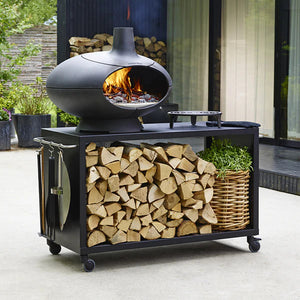How Do I Clean A Wood Burning Stove?

As summer creeps ever closer, you may notice you’re burning your wood burning or multi-fuel stove less and less. Although British springtime may leave something to be desired, it is the perfect time to give your wood burning stove a spring cleaning.
By cleaning your stove regularly it is easier to spot any damages to your stove or to identify if you need any new parts or spares. However, here at Stove Supermarket, we understand that it can seem like a daunting task if you’re not sure where to begin. That’s why we’ve pulled together some top tips on how to tackle your wood burning stove spring cleaning this year.
Before you begin
1. Leave your stove to cool
You should never attempt to clean a stove straight after use. Doing so would risk injury to yourself, and also increases the risk of any hot coals sparking a fire elsewhere in your home. We recommend you wait at least 24 hours at an absolute minimum to ensure the ashes and the stove body have had the appropriate amount of time to cool.
2. Cover the floor surrounding your stove
This step may seem obvious, but it can be easy to forget. We recommend using a layer of old newspaper or cloth to cover the area surrounding your stove and any places where you may leave ash to cool to prevent any stains on your floor or furniture!
3. Remove Internal Parts
It is important to remove all the following internal parts of your wood burning stove before cleaning – baffle, firebricks, grate and ash pan. Not only does this make things easier and prevent any damage to any of the parts, it also allows you to check that they are still in good working condition.
If once you have removed the parts from your stove, you notice that any of the above are damaged, you can purchase a replacement from our great range of wood burning and multi fuel stove spares, parts and accessories.
4. Clear out the fire box
In an ideal world, you would clear out the ashes in your firebox regularly. Too much ash in the bottom of your fire box will impede the airflow and will mean your fire isn’t receiving the oxygen it needs to burn at its most efficient.
To clean the ashes from your fire box you will need a shovel or brush to sweep the ashes into a metal bucket. Cover the ash and set on a non-flammable surface and leave this to sit. This allows any live coals in the ash to cool completely before throwing this away.
Always remember to leave a one-inch layer of ash in the bottom of your stove insulation.
Cleaning the inside of the stove
1. Cleaning the firebox
To clean the inside of the firebox and remove any soot or residue that has not fallen to the bottom of the stove, you will need a stiff bristled brush and a bit of elbow grease to clean this off.
Give the inside of the stove a good scrub with the brush and this should remove any residue. Remove any resulting debris. The fire grate and any grate parts can be easily cleaned with a wire brush. We recommend using short controlled strokes to avoid creating a cloud of fine ash floating around the fire box.
2. Cleaning Stove Glass
An air wash system ensures your stoves glass window is kept cleaner for longer. An air wash is achieved by drawing air into the top of the stove and heating it in a central air chamber. The air is then directed down the inside of the stoves door glass, creating a screen between the fire and the glass. Smoke and combustion particles are blocked from coming into contact with the glass window, resulting in a clearer view of the wood stoves fire. Some great examples of our wood burning stoves that have this clever technology include the Aarrow Ecoburn Plus 5, ACR Rowandale and Parkray Aspect 5.

Although many of our stoves have Airwash systems or similar variations, it won’t keep your glass sparkling clean forever. Also, if your stove has a sooty window this can be a sign that it is not performing at its most efficient. This is a very simple part of your stove to clean and is very easy to keep on top of.
First of all, wipe away any haze build up with a microfiber cloth. Then spray the glass with a pre-mixed glass cleaning solution or a homemade solution of water, vinegar and dish soap. After the solution has reacted for a few minutes, wipe away the residue with your microfiber cloth. The more burnt on the residue, the longer you may have to leave the solution to soak.
A clever alternative is also using old newspaper, residual ash and water. Mix the water and ash together to create a paste, and dip your old newspaper into the mixture before applying to the glass. This may take a bit more work than other options but it is a clever and environmentally friendly way to clean your stove glass.
3. Cleaning the Flue Pipe
When cleaning your wood burning stove it is vital that you also clean your flue pipe. This part of your stove carries the fumes out of the stove and ensures your stove continues to perform at its best.
The flue can become lined with tar and deposits as the waste passes through, so it needs to be checked regularly to ensure it does not become blocked.
While this is possible to complete yourself, you may feel more comfortable getting a professional chimney sweep in to clean the flue for you. Not only will they clean your flue and chimney, they will check to ensure there is no damage. Poorly maintained or blocked chimneys can pose a serious safety risk, so it is important to make sure there are no issues.
4. Check Your Stove Regularly
As well as keeping your stove clean on the inside and the outside, it is vital that you check your stove regularly for any signs of damage. You should also get this checked by a licensed professional at least once a year to ensure everything is in working order.
We would also recommend that during the summertime, when your stove is not in use, removing the throat plate and leaving air inlets open to allow an even flow of air through the stove. This helps to prevent rust and keeps your stove looking and working like new.
- Matthew Wigglesworth










